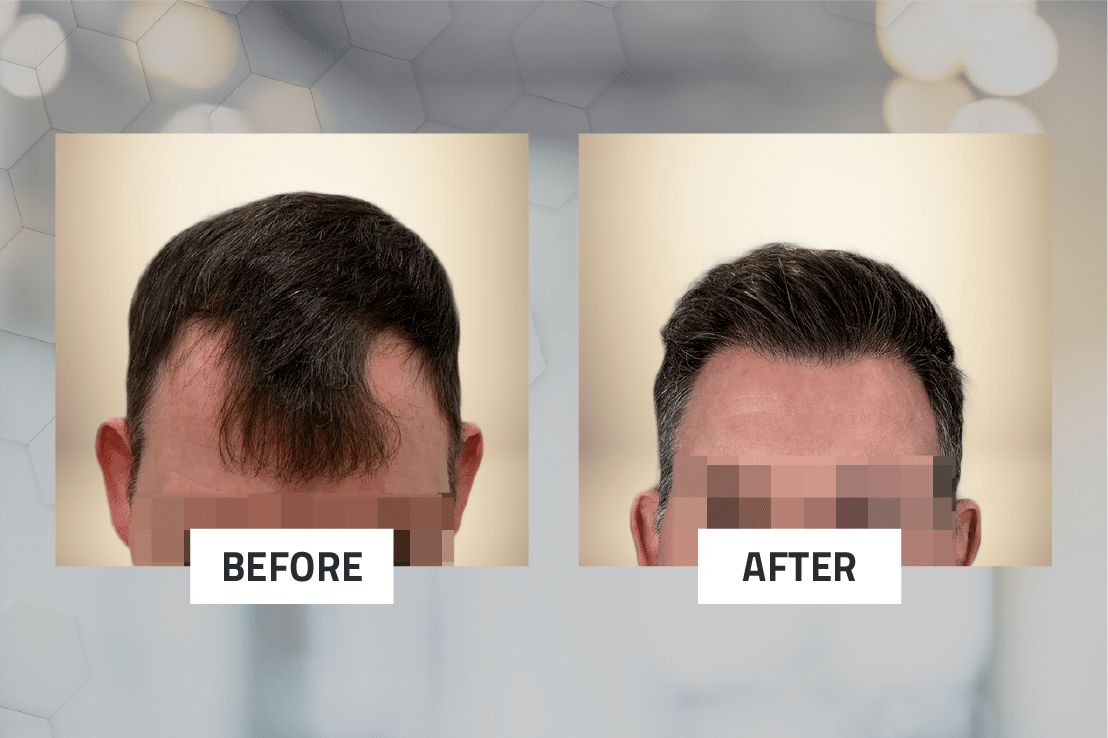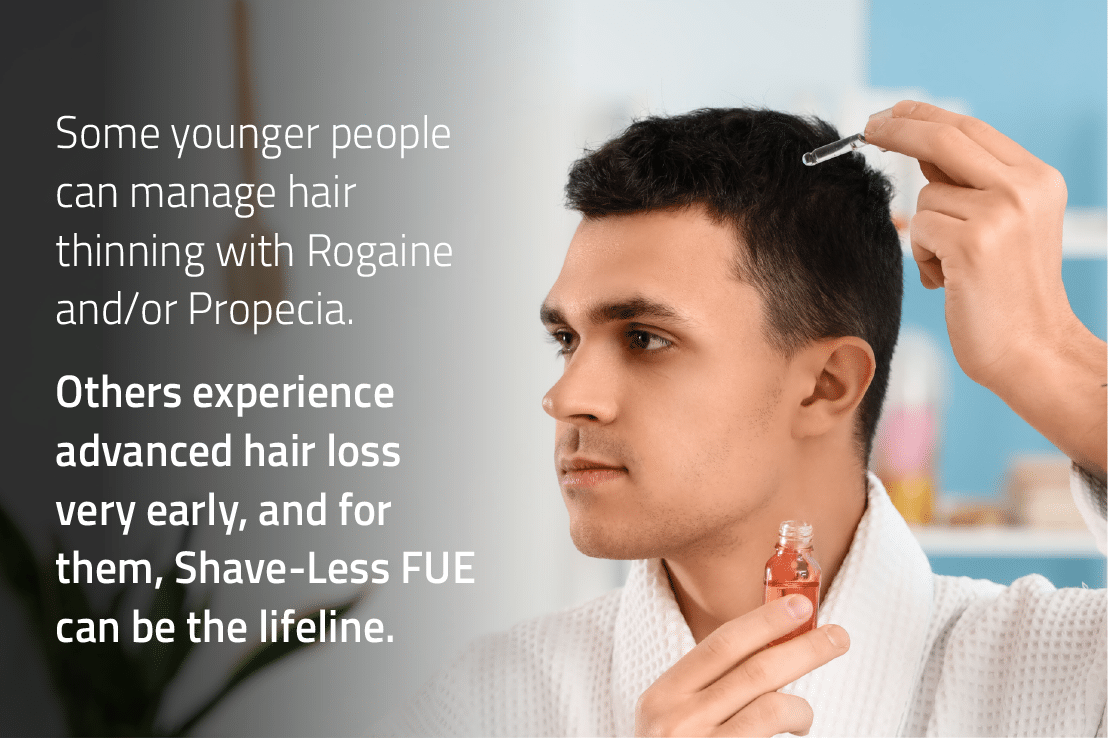If you’re researching your hair loss treatment options, you may have come across the surgical hair restoration procedure known as follicular unit extraction (FUE).
This modern method of hair transplant surgery comes in two main types: traditional FUE, which requires shaving of the donor site and the transplant site, and Shave-Less FUE, also known as No-Shave FUE or Long-Hair FUE.
North Atlanta Hair Restoration specializes in both types of this cutting-edge hair restoration surgery.
How Does a FUE Hair Transplant Work?
Unlike the older strip transplantation method FUT (Follicular Unit Transplantation), FUE harvests much smaller groups of individual hair follicles (known as follicular units) for transplantation.
These smaller hair grafts can then be carefully placed and blended into thinning areas to achieve more natural-looking results.
FUE is a finer, more precise method of surgical hair transplantation, and it doesn’t leave a telltale linear scar like FUT, so the results at both the donor and recipient sites are more discreet.
What Is Shave-Less FUE?
The main drawback to regular FUE for most people is that it requires some shaving of the head.
This can be a real mental and logistical hurdle for those who value discretion, for those with longer hair, and especially for women seeking hair transplants.
Thankfully, there is a No-Shave FUE technique – Shave-Less FUE – that doesn’t require shaving the head at all.

With most Shave-Less FUE hair transplant procedures, the donor hair length can be preserved, or the procedure can be performed with only minimal hair cutting.
The result is that patients get to leave their transplant session looking largely as they did when they walked in – with no shaved areas to cover up, no awkward haircut, and no need to take time off from work or social obligations.
9 Benefits of Getting Shave-Less FUE
The advantages of Shave-Less FUE are many, and they include:
- Minimal scarring
- Minimal downtime
- Minimal pain
- Minimal infection risk
- Short recovery times
- Natural, well-blended results
- High graft viability/success rate
- No head shaving required
- Suitable for small or large transplants
Are There Any Drawbacks to Shave-Less FUE?
One drawback to No-Shave FUE is that not all hair restoration clinics offer it, and not all of those who do know how to do it well.
Shave-Less FUE generally takes longer than Shaved FUE, so for larger transplants, you’ll need an experienced surgical team who works efficiently and seamlessly.
No-Shave FUE also requires a higher level of skill to ensure high graft viability and low transection rates.
For these reasons, it can sometimes – but not always – be more expensive than regular FUE, so those who don’t mind shaving sometimes just default to choosing regular FUE.
However, for those who prefer the least disruption and the greatest discretion, Shave-Less FUE is the superior option and well worth the additional cost.
Who Is a Good Candidate for Shave-Less FUE?
Most people facing hair loss – including men and women, and people of a variety of ethnicities – are usually good candidates for Shave-Less FUE.
No-Shave FUE is often a good option for people with:
- Natural hairline recession. This is a common problem, and people with this kind of hair loss tend to do very well with Shave-Less FUE.
- Severe balding. Those with extensive hair loss, including at the hairline, middle scalp and crown, can be good candidates for No-Shave FUE. Beard and chest donor sites may be used to achieve desired coverage and density.
- Traction alopecia. This often-permanent hair loss issue affects many African-American women and can occur as a result of tight braids or hair weaves.
- Flawed or failed previous transplants. Shave-Less FUE is often used to discreetly correct poor results from previous hair transplants, including FUT.
- Beard and body hair loss. No-Shave FUE transplantation can also be used to restore growth to thin beard or body hair areas, including the eyebrows.
People with certain types of scarring alopecia may not respond well to either Shaved or Shave-Less FUE, but those cases are pretty rare.
Whatever your hair loss situation, an expert hair restoration surgeon can assess your case and let you know whether Shave-Less FUE – or another hair restoration option – might be right for you.
Am I Too Young for Shave-Less FUE?
Younger folks, particularly those in the very earliest stages of hair loss, may be able to medically manage hair thinning with Rogaine (minoxidil), Propecia (finasteride), or both.
Other non-surgical hair restoration options for those low on the Norwood Scale include PDO threads, Platelet-Rich Plasma (PRP) injections, and Scalp Micropigmentation (SMP).
However, some younger people experience advanced hair loss very early, and for them, Shave-Less FUE can be the lifeline that restores their normal-looking appearance and confidence.

Although it is not all that common, even those under 30 with genetic early onset hair loss can be good candidates a FUE or No-Shave hair transplant.
Am I Too Old for Shave-Less FUE?
As long as you’re in good enough health for a surgical hair transplant procedure, you’re likely not too old for Shave-Less FUE.
Shave-Less FUE has very good success rates in people across a wide range of ages, so being over 50 – or 60, or 70, or even 80 – should be no deterrent to seeking hair restoration advice.
And as long as you have enough viable donor sites available – and these can be on the head, beard and body – advanced baldness is also not a disqualifier for No-Shave FUE hair transplant surgery.
Of course, the best way to know if Shave-Less FUE is the right choice at your age and for your situation is to get an expert assessment from a qualified hair restoration specialist.
Still Wondering if Shave-Less FUE Is Right for You?
We can help. For over a decade, North Atlanta Hair Restoration has been helping people of all ages and types get a fuller head of hair using the latest medical advances.
Our founder Dr. Danyo specializes in traditional and No-Shave FUE techniques, and he and his expert medical team can help you achieve the results you desire.
Call us today at (678) 845-7521 to schedule a virtual or in-person consultation, or book online to find out if Shave-Less FUE might be the hair loss solution you’ve been seeking.


